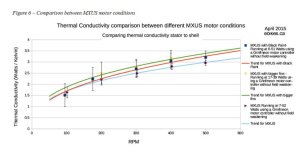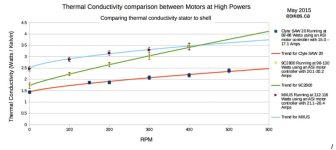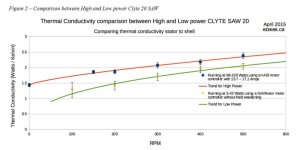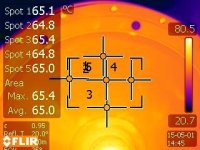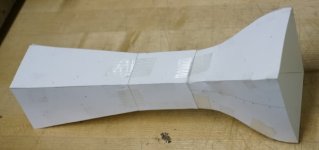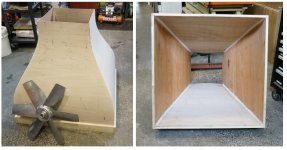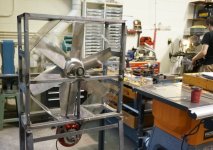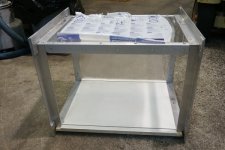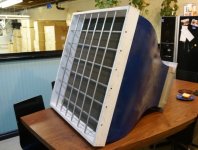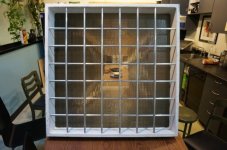Here is a summary of most of the test data acquired from the past couple weeks. I'd like to publicly thank Akshiv, a junior engineering physics student we've had on a short work term here, who has painstakingly run most of the experiments and number crunching.
When we started these tests, we decided to see how well it would work as a methodology to simply run the motors unloaded at various speeds and wait for the temperatures of the motor core and shell to reach equilibrium, because this is a technique that almost anyone could replicate on their own with no fancy equipment. The downside is that the power going into the motor is quite low, on the order of 10-40 watts depending on the motor and RPM, and so we are dealing with much lower temperature variations than what you would have in practice with a loaded hub. I'd previously summarized these results on the 3 motors under test (the small SAW20 motor, the 9C hub, and the 45mm wide MXUS hub), and here it is again with error bars and also including the run with the MXUS motor having radial fins installed on the insides of the side plate:
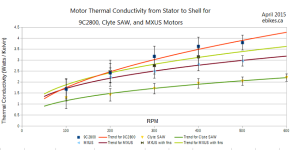
You can see that the fins did improve things about 10-15%, but still not enough to equal the thermal conductivity of the narrower 9C motor,
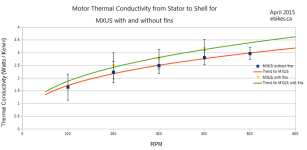
The question we also wanted to answer was whether the heat conduction term was constant enough over temperature differentials that the values measured at low unloaded powers extrapolate to the high power regime OK? Normally to test the motor at high watts of heat you would need to load it down. But that gets complicated mechanically, and electronically it also means that you can't simply measure the electrical watts going into the hub to figure out how much heat is generated as a majority of the input power is doing mechanical work against the load. We had actually purchased some rolls of nichrome wire that we were going to embed to the inside of the stator to give us a controlled thermal input from a heating element and external power supply, but then realized we could achieve the same effect much more easily by using a field oriented motor controller and setting a large field weakening current to apply at all RPMs.
With the 9C hub, we set the field weakening current to 30 amps, so even though the unloaded draw of the motor is just like 1-2 amps, there is on top of this 30 amps of out-of-phase current flowing through the phase wires doing nothing but fighting the field of the permanent magnets. That way we can have an appreciable amount of I^2R heat generation, exactly like if the motor was being loaded to 30 amps, but without the complexity. And because there is no mechanical power coming out of the spinning motor, we can conclude that all electrical watts going into the system is turning into heat in the core. For the different motors, we adjusted the field weakening currents so hat the motor core temperatures reached steady state in the 100-130 degree range.
For the 9C motors, the heat conductivity terms measured at high powers like this were very similar to the lower power unloaded tests, within the margins of measurement error:
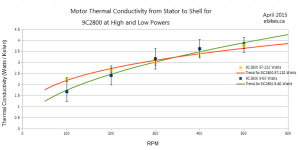
With the smaller SAW20 motor, there was a definite increase in the thermal conductivity at the higher temperature tests than the unloaded tests:
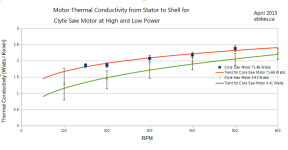
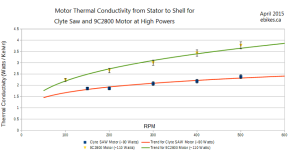
From now on we'll be using this technique with field weakening to get higher heat input levels.
I've gotta leave for the next 4 days but once back we will have the test data for the MXUS motor with the side covers and core painted.
When we started these tests, we decided to see how well it would work as a methodology to simply run the motors unloaded at various speeds and wait for the temperatures of the motor core and shell to reach equilibrium, because this is a technique that almost anyone could replicate on their own with no fancy equipment. The downside is that the power going into the motor is quite low, on the order of 10-40 watts depending on the motor and RPM, and so we are dealing with much lower temperature variations than what you would have in practice with a loaded hub. I'd previously summarized these results on the 3 motors under test (the small SAW20 motor, the 9C hub, and the 45mm wide MXUS hub), and here it is again with error bars and also including the run with the MXUS motor having radial fins installed on the insides of the side plate:

You can see that the fins did improve things about 10-15%, but still not enough to equal the thermal conductivity of the narrower 9C motor,

The question we also wanted to answer was whether the heat conduction term was constant enough over temperature differentials that the values measured at low unloaded powers extrapolate to the high power regime OK? Normally to test the motor at high watts of heat you would need to load it down. But that gets complicated mechanically, and electronically it also means that you can't simply measure the electrical watts going into the hub to figure out how much heat is generated as a majority of the input power is doing mechanical work against the load. We had actually purchased some rolls of nichrome wire that we were going to embed to the inside of the stator to give us a controlled thermal input from a heating element and external power supply, but then realized we could achieve the same effect much more easily by using a field oriented motor controller and setting a large field weakening current to apply at all RPMs.
With the 9C hub, we set the field weakening current to 30 amps, so even though the unloaded draw of the motor is just like 1-2 amps, there is on top of this 30 amps of out-of-phase current flowing through the phase wires doing nothing but fighting the field of the permanent magnets. That way we can have an appreciable amount of I^2R heat generation, exactly like if the motor was being loaded to 30 amps, but without the complexity. And because there is no mechanical power coming out of the spinning motor, we can conclude that all electrical watts going into the system is turning into heat in the core. For the different motors, we adjusted the field weakening currents so hat the motor core temperatures reached steady state in the 100-130 degree range.
For the 9C motors, the heat conductivity terms measured at high powers like this were very similar to the lower power unloaded tests, within the margins of measurement error:

With the smaller SAW20 motor, there was a definite increase in the thermal conductivity at the higher temperature tests than the unloaded tests:


From now on we'll be using this technique with field weakening to get higher heat input levels.
I've gotta leave for the next 4 days but once back we will have the test data for the MXUS motor with the side covers and core painted.


